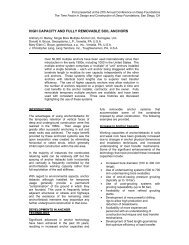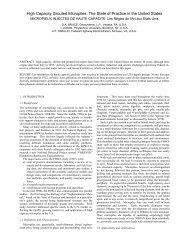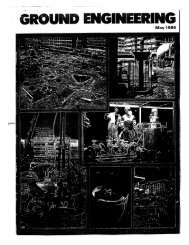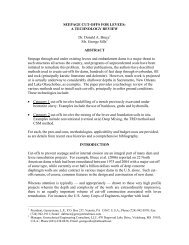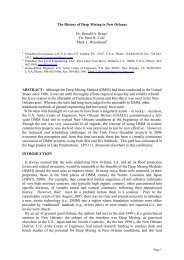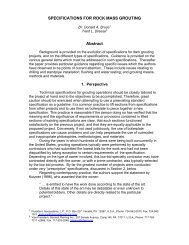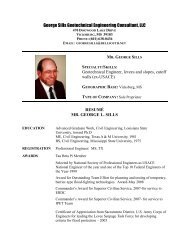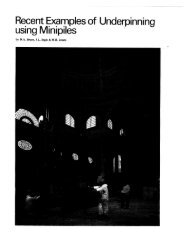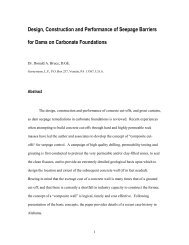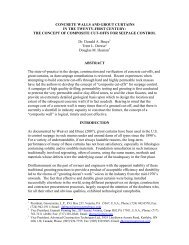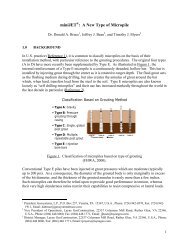1 Dam Remediation by Anchors and Cut-Offs: A ... - Geosystems, LP
1 Dam Remediation by Anchors and Cut-Offs: A ... - Geosystems, LP
1 Dam Remediation by Anchors and Cut-Offs: A ... - Geosystems, LP
Create successful ePaper yourself
Turn your PDF publications into a flip-book with our unique Google optimized e-Paper software.
3.3 Observations <strong>and</strong> Lessons Learned<br />
3.3.1 Investigations, Design, Specifications <strong>and</strong> Contractor Procurement<br />
(i) Intensive, focused site investigations are essential as the basis for cut-off design <strong>and</strong><br />
contractor bidding purposes. In particular, these investigations must not only identify rock<br />
mass lithology, structure <strong>and</strong> strength, but also the potential for loss of slurry during panel<br />
excavation. This has not always been done, <strong>and</strong> cost <strong>and</strong> schedule have suffered<br />
accordingly on certain major projects.<br />
(ii) Special considerations have had to be made when designing cut-offs which must contact<br />
existing concrete structures, or which must be installed in very deep-sided valley sections,<br />
or which must toe in to especially strong rock.<br />
(iii) “Test Sections” have proved to be extremely valuable, especially for the contractor to refine<br />
his means, methods <strong>and</strong> quality control systems. Such programs have also given the dam<br />
safety officials <strong>and</strong> owners the opportunity to gain confidence <strong>and</strong> underst<strong>and</strong>ing in the<br />
response of their dams to the invasive surgery that constitutes cut-off wall construction.<br />
Furthermore, such programs have occasionally shown that the foreseen construction<br />
method was practically impossible (e.g., a hydromill at Beaver <strong>Dam</strong>, AR) or that significant<br />
facilitation works (e.g., pregrouting of alignment at Mississinewa <strong>Dam</strong>, IN) were required.<br />
(iv) Every project has involved a high degree of risk <strong>and</strong> complexity <strong>and</strong> has dem<strong>and</strong>ed superior<br />
levels of collaboration between designer <strong>and</strong> contractor. This situation has been best<br />
satisfied <strong>by</strong> procuring a contractor on the basis of “best value,” not “low bid.” This<br />
involves the use of RFP’s (Requests for Proposals) with a heavy emphasis on the technical<br />
submittal <strong>and</strong>, in particular, on corporate experience, expertise <strong>and</strong> resources, <strong>and</strong> the<br />
project-specific Method Statement. These projects are essentially based on Performance, as<br />
opposed to Prescriptive Specifications . Partnering arrangements (which are post-contract)<br />
have proved very useful to both parties when entered into with confidence <strong>and</strong> enthusiasm.<br />
(i)<br />
(ii)<br />
3.3.2 Construction <strong>and</strong> QA/QC<br />
The specialty contractors have developed a wide <strong>and</strong> responsive variety of equipment <strong>and</strong><br />
techniques to assure penetration <strong>and</strong> wall continuity in all ground conditions. More than<br />
one technique, e.g., clamshell followed <strong>by</strong> hydromill, has frequently been used on the same<br />
project <strong>and</strong> especially where bouldery conditions have been encountered.<br />
<strong>Cut</strong>-offs can be safely constructed with high lake levels, provided that the slurry level can<br />
be maintained a minimum of 3 feet higher. In extreme geological conditions, this may<br />
dem<strong>and</strong> pretreatment of the embankment (e.g., Mud Mountain <strong>Dam</strong>, WA) or the rock mass<br />
(Mississinewa <strong>Dam</strong>, IN) to guard against massive, sudden slurry loss.<br />
(iii) In less severe conditions, contractors have also developed a variety of defenses against<br />
slurry losses of smaller volume <strong>and</strong> rate <strong>by</strong> providing large slurry reserves, flocculating<br />
agents, fillers, or <strong>by</strong> limiting the open-panel width.<br />
(iv) Very tight verticality tolerances are necessary to assure, <strong>and</strong> especially in deeper cut-offs,<br />
but have been not only difficult to satisfy, but also difficult to measure accurately. Such<br />
deviation tolerances have been measured to be less than 0.5% of the wall depth.<br />
26



